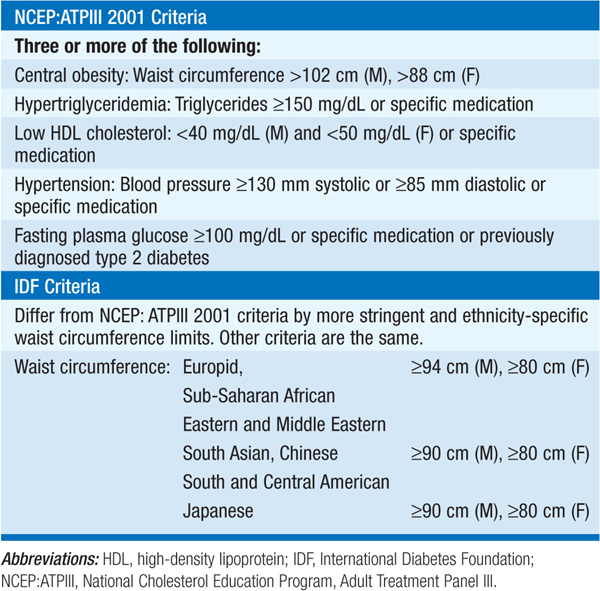
The metabolic syndrome (insulin resistance syndrome, syndrome X) is an important risk factor for cardiovascular disease and type 2 diabetes; it consists of a constellation of metabolic abnormalities that includes central obesity, insulin resistance, hypertension, dyslipidemia, and endothelial dysfunction. The prevalence of metabolic syndrome varies among ethnic groups; it increases with age, degree of obesity and propensity to type 2 diabetes. In the United States, 44% of persons over age 50 have the metabolic syndrome; women are affected in greater numbers than men.
Overweight/obesity (especially central adiposity), sedentary lifestyle, increasing age, and lipodystrophy are all risk factors for the metabolic syndrome. The exact cause is not known and may be multifactorial. Insulin resistance is central to the development of the metabolic syndrome. Increased intracellular fatty acid metabolites contribute to insulin resistance by impairing insulin-signaling pathways and accumulating as triglycerides in skeletal and cardiac muscle, while stimulating hepatic glucose and triglyceride production. Excess adipose tissue leads to increased production of proinflammatory cytokines.
There are no specific symptoms of the metabolic syndrome. The major features include central obesity, hypertriglyceridemia, low HDL cholesterol, hyperglycemia, and hypertension (Table 127-1). Associated conditions include cardiovascular disease, type 2 diabetes, nonalcoholic fatty liver disease, hyperuricemia/gout, polycystic ovary syndrome, and obstructive sleep apnea.
TABLE 127-1 NCEP:ATPIII 2001 AND IDF CRITERIA FOR THE METABOLIC SYNDROME

The diagnosis of the metabolic syndrome relies on satisfying the criteria listed in Table 127-1. Screening for associated conditions should be undertaken.
TREATMENT Metabolic Syndrome
Obesity is the driving force behind the metabolic syndrome. Thus, weight reduction is the primary approach to this disorder. In general, recommendations for weight loss include a combination of caloric restriction, increased physical activity, and behavior modification. Weight loss drugs (orlistat) or bariatric surgery are adjuncts that may be considered for obesity management (Chap. 183). Metformin or thiazolidinedione (pioglitazone) reduce insulin resistance. Hypertension (Chap. 126), impaired fasting glucose or diabetes (Chap. 184), and lipid abnormalities (Chap. 189) should be managed according to current guidelines. The antihypertensive regimen should include an angiotensin-converting enzyme (ACE) inhibitor or angiotensin receptor blocker when possible.